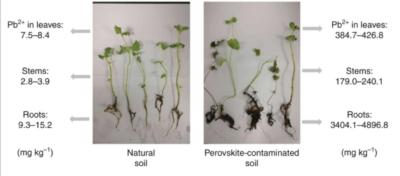Researchers led by Prof. Antonio Abate at the Helmholtz-Zentrum Berlin have designed a study to investigate lead hazards relating to perovskite soar cells. They cooperated with plant scientists from the Fujian Agriculture and Forestry University, China, where the experiments were carried out, and with a group from the university of Naples, Italy.
 Mint plants grown on control soil (left) and perovskite-contaminated soil (right). Credit: Nature
Mint plants grown on control soil (left) and perovskite-contaminated soil (right). Credit: Nature
The plant experts prepared contaminated soil samples with different concentrations of lead from either perovskite solar cells or other lead sources and cultivated different plants. After a growth period, they analyzed the lead content in leaves and other parts of the plant. They found that lead from perovskite solar cells is 10 times more bioavailable than lead from other industrial sources.
Abate is working on the development of lead-free perovskite solar cells containing tin. Tin is also highly toxic, although it reacts very quickly to non-water-soluble forms. A series of experiments with mint plants on tin-contaminated soil showed that the plants absorb only a small amount of it. Lead-free perovskite solar cells, however, still fall short of the high efficiencies of lead-containing solar cells, and also have even greater problems with stability.
The Helmholtz-Zentrum Berlin has expertise in the field of perovskite solar cells with or without lead. "We have to investigate this class of materials very broadly," Abate says: "Of course, it is important to increase efficiencies and longtime stability, but we need as well to make sure that these materials do not pose a risk for the environment."



